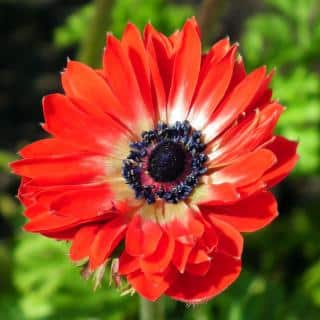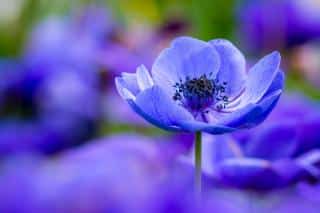

Anemone coronaria is a unique and very decorative bulb flower. Its brilliant red bloom is similar to that of the poppy flower.
Key points to remember
Name – Anemone coronaria
Family – Ranunculaceae
Type – Tuberous perennial
Height – 2 to 12 inches (5 to 30 cm)
Exposure – Full sun and part sun
Soil – ordinary, well drained
Flowering – March to May or September/October
It will decorate edges and rocky ground but also flower beds and bouquets in spring or summer. If you’ve got a terrace or balcony, it will also grow well in garden boxes and containers.
Poppy anemone is a tuber plant. Since they’re round and flat like those of cyclamen, some people call them “patties”. You must place the tubers in the ground in spring or in fall (preference for fall) and always in well drained soil, or even sandy soil, to avoid any excess moisture that might lead the bulbs to rot.
 First of all, soak the tuber roots for 1 or 2 hours in water. They’ll swell as they take the water in.
First of all, soak the tuber roots for 1 or 2 hours in water. They’ll swell as they take the water in.Propagating Anemone coronaria It is very simple to do, and it’s even recommended to multiply your poppy anemones every 2 or 3 years to regenerate the growth base and thus rejuvenate older bulbs.
There’s no trimming needed, but you can still eliminate flowers as they wilt away. This triggers renewed blooming.
Once all the leaves have dried out, and in no case before they have done so, you can cut them off very short before winter. Simply spread the cut leaves together with other dried leaves over the root tubers to protect them from the cold.
You can either leave the tubers in the ground, or dig them out for storage indoors in a cool, dry spot that doesn’t freeze over.
Most anemone species bloom several times during the year from Spring to Fall, but Anemone coronaria only blooms until the end of Summer. Note that the name “Spanish marigold” also designates this Anemone coronaria.

Other species and varieties of spring-blooming anemones include Anemone blanda or Grecian windflower, Anemone apennina. On the other hand, anemone species that bloom in Summer or Fall typically include the famous Japanese anemone, Anemone bupehensis and Anemone rivularis which is actually the earliest summer bloomer. These are all perfect for lining edges, and also will thrive in underbrush or to cover a bare surface.
Flowers are generally blue or white, but some species will boast red or purple flowers. They appear in spring, around April to May.
Watch out if you have children because this plant is poisonous. It shouldn’t be ingested.